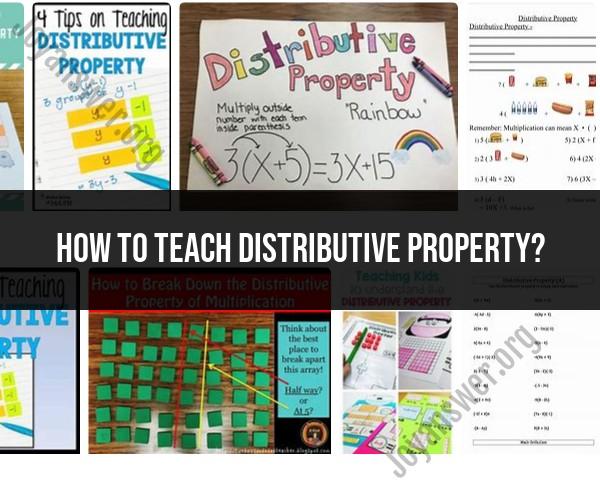How to teach distributive property?
Teaching the distributive property can be challenging for some students, but there are several effective strategies that can help make this fundamental mathematical concept more understandable. Here are some strategies to consider:
Use Visual Aids:
- Visual aids such as diagrams, manipulatives, or models can be very helpful. You can use drawings, blocks, or other objects to represent the numbers and operations involved.
- For example, you can use rectangles to represent the numbers, and show how breaking down a larger rectangle into smaller ones illustrates the distributive property.
Real-Life Examples:
- Relate the distributive property to real-life situations. For instance, you can explain how distributing money or items among a group of people can be thought of as using the distributive property.
Hands-On Activities:
- Engage students in hands-on activities. Give them physical objects to manipulate and demonstrate the property. For example, you can use candies or coins to show how distributing them among groups follows the distributive property.
Interactive Games and Puzzles:
- Use interactive games or puzzles to make learning fun. There are many educational apps and websites that offer interactive exercises related to the distributive property.
Step-by-Step Approach:
- Break the concept down into smaller, manageable steps. Start with simple examples and gradually increase the complexity as students become more comfortable with the idea.
Pattern Recognition:
- Encourage students to look for patterns. Ask them to work on a series of problems and identify the pattern when the distributive property is applied.
Storytelling:
- Create stories or word problems that require the use of the distributive property. Relatable scenarios can help students grasp the concept more easily.
Multiple Representations:
- Show the concept in different ways. For example, use numbers, variables, and word problems to help students see that the distributive property applies in various situations.
Peer Teaching:
- Encourage students to work together and teach each other. Peer teaching can reinforce the concept and help students learn from their peers.
Practice, Practice, Practice:
- Provide plenty of practice problems. The more students work with the distributive property, the more confident they'll become in using it.
Use Mnemonics or Acronyms:
- Some students find it helpful to use a mnemonic or acronym to remember the steps involved in the distributive property. For example, you can use the acronym "FOIL" for multiplying binomials, where F stands for first, O stands for outside, I stands for inside, and L stands for last.
Relate to Previous Knowledge:
- Connect the distributive property to concepts students are already familiar with, such as addition, multiplication, or even the commutative and associative properties.
Encourage Questions:
- Create a classroom environment where students feel comfortable asking questions. Address any misconceptions or confusion promptly.
Assessment and Feedback:
- Regularly assess students' understanding of the distributive property and provide feedback to help them improve.
Remember that different students have different learning styles, so it's essential to use a combination of these strategies and adapt your teaching approach to best meet the needs of your students. Patience and reinforcement are key when teaching the distributive property.
How to teach the distributive property in mathematics education?
Here are some tips for teaching the distributive property in mathematics education:
- Start with a concrete example. For example, you could ask students to imagine that they have 10 candies and they want to divide them equally among 3 friends. How many candies will each friend get? You can then show them how to use the distributive property to solve this problem.
- Use visual representations. One way to help students understand the distributive property is to use visual representations. For example, you could use a rectangular area to represent the product of two numbers. The length of the rectangle represents the first number, and the width of the rectangle represents the second number. The area of the rectangle represents the product of the two numbers. To prove the distributive property, you can divide the rectangle into two smaller rectangles, one for each addend in the sum. The sum of the areas of the two smaller rectangles will be equal to the area of the original rectangle.
- Connect the distributive property to other mathematical concepts. The distributive property is related to other mathematical concepts, such as multiplication, addition, and factoring. You can help students understand the distributive property by connecting it to these other concepts. For example, you could show students how to use the distributive property to factor polynomials.
- Provide students with opportunities to practice. The best way for students to learn the distributive property is to practice using it. You can provide students with opportunities to practice by giving them worksheets, homework assignments, and quizzes.
What are the steps and approaches for instructing students about the distributive property?
Here are some steps and approaches for instructing students about the distributive property:
- Introduce the distributive property. Explain to students what the distributive property is and how it works. You can use a concrete example or a visual representation to help students understand.
- Show students how to use the distributive property. Show students how to use the distributive property to solve multiplication problems. You can provide students with examples or have them practice solving problems with your guidance.
- Give students opportunities to practice using the distributive property. Give students worksheets, homework assignments, and quizzes to help them practice using the distributive property. You can also have students work with partners or in small groups to solve problems.
- Assess students' understanding of the distributive property. Give students a quiz or test to assess their understanding of the distributive property. You can also ask students to explain their thinking when solving problems.
- Provide students with additional support as needed. If some students are struggling to understand the distributive property, provide them with additional support. You can give them one-on-one tutoring, provide them with additional resources, or have them work with a peer tutor.
Can you provide lesson plans or activities for teaching the distributive property effectively?
Here is a lesson plan for teaching the distributive property to elementary school students:
Lesson Plan: The Distributive Property
Objectives:
- Students will be able to define the distributive property.
- Students will be able to use the distributive property to solve multiplication problems.
Materials:
- Whiteboard or projector
- Markers or pens
- Paper
- Concrete objects (such as blocks, counters, or manipulatives)
Procedure:
- Introduction:
- Begin by asking students to imagine that they have 10 candies and they want to divide them equally among 3 friends. How many candies will each friend get?
- Explain to students that they can use the distributive property to solve this problem.
- Write the following equation on the board:
10 = 3 + 3 + 3 + 1
- Explain to students that the distributive property tells us that 10 x 3 is the same as 3 + 3 + 3 + 1.
- Activity:
- Give each student a set of concrete objects (such as blocks, counters, or manipulatives).
- Have students use the concrete objects to model the distributive property equation: 10 = 3 + 3 + 3 + 1.
- Once students have modeled the equation, ask them to explain how the concrete objects represent the distributive property.
- Guided Practice:
- Provide students with a few multiplication problems to solve using the distributive property.
- Give students time to work on the problems independently, and then circulate around the room to provide assistance as needed.
- Independent Practice:
- Give students a worksheet with multiplication problems to solve using the distributive property.
- Have students work independently on the worksheet.
- Assessment:
- Give students a quiz or test to assess their understanding of the distributive property.
How to assess and reinforce understanding of the distributive property in the classroom?
Here are some ways to assess and reinforce understanding of










